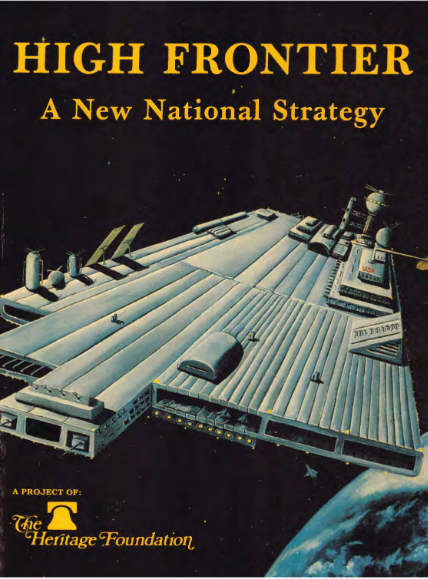Forty years ago today, on the evening of 1983-03-23, U.S. President Ronald Reagan spoke from the Oval Office in an “Address to the Nation on Defense and National Security” (link is to an official transcript from the Ronald Reagan Presidential Library and Museum). The bulk of the speech was a reaffirmation of the “peace through strength” message that Reagan had advocated long before running for president, and a summary of the Soviet military build-up which threatened to destabilise the strategic balance, aided by the “nuclear freeze” movement in the West. Reagan argued:
I know that all of you want peace, and so do I. I know too that many of you seriously believe that a nuclear freeze would further the cause of peace. But a freeze now would make us less, not more, secure and would raise, not reduce, the risks of war. It would be largely unverifiable and would seriously undercut our negotiations on arms reduction. It would reward the Soviets for their massive military buildup while preventing us from modernizing our aging and increasingly vulnerable forces. With their present margin of superiority, why should they agree to arms reductions knowing that we were prohibited from catching up?
Believe me, it wasn’t pleasant for someone who had come to Washington determined to reduce government spending, but we had to move forward with the task of repairing our defenses or we would lose our ability to deter conflict now and in the future. We had to demonstrate to any adversary that aggression could not succeed, and that the only real solution was substantial, equitable, and effectively verifiable arms reduction – the kind we’re working for right now in Geneva.
It was at the end of the speech that Reagan advocated a new strategy against the sword of Damocles that thousands of ballistic missiles armed with nuclear warheads held over the world.
If the Soviet Union will join with us in our effort to achieve major arms reduction, we will have succeeded in stabilizing the nuclear balance. Nevertheless, it will still be necessary to rely on the specter of retaliation, on mutual threat. And that’s a sad commentary on the human condition. Wouldn’t it be better to save lives than to avenge them? Are we not capable of demonstrating our peaceful intentions by applying all our abilities and our ingenuity to achieving a truly lasting stability? I think we are. Indeed, we must.
After careful consultation with my advisers, including the Joint Chiefs of Staff, I believe there is a way. Let me share with you a vision of the future which offers hope. It is that we embark on a program to counter the awesome Soviet missile threat with measures that are defensive. Let us turn to the very strengths in technology that spawned our great industrial base and that have given us the quality of life we enjoy today.
What if free people could live secure in the knowledge that their security did not rest upon the threat of instant U.S. retaliation to deter a Soviet attack, that we could intercept and destroy strategic ballistic missiles before they reached our own soil or that of our allies?
I know this is a formidable, technical task, one that may not be accomplished before the end of this century. Yet, current technology has attained a level of sophistication where it’s reasonable for us to begin this effort. It will take years, probably decades of effort on many fronts. There will be failures and setbacks, just as there will be successes and breakthroughs. And as we proceed, we must remain constant in preserving the nuclear deterrent and maintaining a solid capability for flexible response. But isn’t it worth every investment necessary to free the world from the threat of nuclear war? We know it is.
⋮
I clearly recognize that defensive systems have limitations and raise certain problems and ambiguities. If paired with offensive systems, they can be viewed as fostering an aggressive policy, and no one wants that. But with these considerations firmly in mind, I call upon the scientific community in our country, those who gave us nuclear weapons, to turn their great talents now to the cause of mankind and world peace, to give us the means of rendering these nuclear weapons impotent and obsolete.
Tonight, consistent with our obligations of the ABM treaty and recognizing the need for closer consultation with our allies, I’m taking an important first step. I am directing a comprehensive and intensive effort to define a long-term research and development program to begin to achieve our ultimate goal of eliminating the threat posed by strategic nuclear missiles. This could pave the way for arms control measures to eliminate the weapons themselves. We seek neither military superiority nor political advantage. Our only purpose – one all people share – is to search for ways to reduce the danger of nuclear war.
My fellow Americans, tonight we’re launching an effort which holds the promise of changing the course of human history. There will be risks, and results take time. But I believe we can do it. As we cross this threshold, I ask for your prayers and your support.
Here is video of the speech, again courtesy of the Reagan Library. The first passage I quoted, addressing the nuclear freeze” starts at 16:46. The second, describing what came to be called the Strategic Defense Initiative (SDI), is at 24:06.
The Strategic Defense Initiative, as described by Reagan in March, 1983, was one component of the comprehensive “High Frontier” strategy developed by U.S. Army lieutenant general Daniel O. Graham who served as deputy director of the CIA and director of the Defense Intelligence Agency. Graham was military advisor to the Reagan presidential campaigns of 1976 and 1980. In 1981, he founded High Frontier, Inc., a private organisation promoting space-based technology strategies for national defense. (This should not be confused with the space colonies advocated by Gerard K. O’Neill in his 1976 book, The High Frontier.) Graham assembled a “kitchen cabinet” of defense intellectuals, technologists, and space visionaries which, beginning with meetings in Jerry Pournelle’s house in Studio City, California, hammered out the High Frontier strategy, which was published in February, 1982 by the Heritage Foundation as High Frontier: A New National Strategy [PDF, 200 pages], which you can read in its entirety or download from the link on the title. Graham’s High Frontier was a national strategy to become a spacefaring nation and went well beyond the goals of what was adopted by SDI.
Space holds out the promise of a new era of economic expansion. The unique environment of space—zero gravity, near perfect vacuum, unlimited heat absorption, and sterile conditions—opens up a broad range of industrial/commercial possibilities. Space also contains inexhaustible supplies of minerals and solar energy. The economic potential of space is already being tapped in the communications industry. As the cost of space transportation is lowered, the industrialization of space will burgeon. However, the capital investment in space industries will be quite large and unlikely to be undertaken if space installations are indefensible against hostile attack. For this reason, military capabilities in space are critical to space based economic growth.
Graham’s High Frontier was, in turn, strongly influenced by The Strategy of Technology, published in 1970 by Stefan Possony, Jerry Pournelle, and Francis Kane, which has been used as textbook at the United States Military Academy, Air Force Academy, Air War College, and National War College. The link in the title is to an online edition prepared in 1991 which looks like you’d expect for a document from the early days of the Internet, but is entirely readable.
Here was the first vision of hope for a future in which one’s life was not perpetually half an hour from extinction if somebody on the other side of the world fat-fingered a button of some dim-witted politician bungled their way into open superpower warfare. At the same time, the technologies which could pave the way to that future would, necessarily, open the door to expanding the human presence and economic activity from the surface of the Earth into the abundance awaiting beyond in the solar system.
SDI was, of course, a mortal threat to admirers of Soviet communism who had advocated for unilateral nuclear disarmament since the start of the Cold War, and perceived and rapidly exploited by the ravenous razorback hogs of the defense contractor world, fighting for their place at a new federal trough brimming with taxpayer funds. The “arms control” establishment viewed it as as a threat at least as much as did the Soviets, since it would render their endless negotiations, draft agreements, white papers, and lucrative contracts studying the “strategic balance”, opposing weapons systems, and monitoring Soviet military developments, in the words of the President, “impotent and obsolete”. “Why, this daft old man in the White House actually wants to win the Cold War! We’ll all be out of our jobs!”
This resulted in SDI being quickly buried under a pile of derision from the political and media complex, making it almost impossible to communicate the reality of the problem and technologies being developed to solve them. There were no illusions of a “magic bullet”: recall that Reagan said “I know this is a formidable, technical task, one that may not be accomplished before the end of this century. ” But nothing will ever be accomplished, ever, unless you start working on it.
Forty years after the announcement of the Strategic Defense Initiative, the U.S has 1644 strategic nuclear weapons and Russia has 1588, many on solid-fuel missiles ready to launch at a moment’s notice. Unlike in March 1983, forces backed and armed by NATO are in direct conflict with the Russian military on the European continent, with the Russian president saying in February 2023,
They intend to transform a local conflict into a phase of global confrontation. This is exactly how we understand it all and we will react accordingly, because in this case we are talking about the existence of our country.
Happy fortieth anniversary, SDI!

